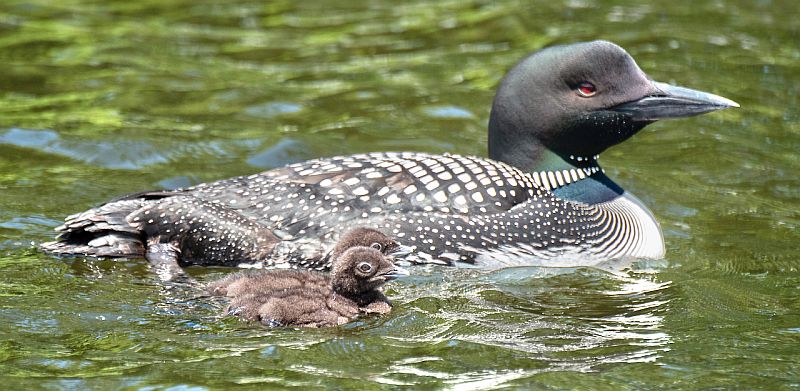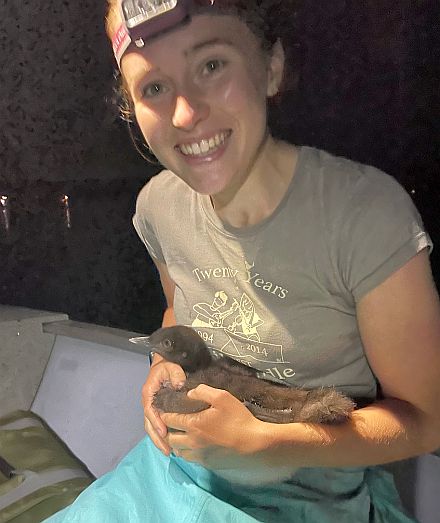
Why is Studying Loons Important?

As an intern with the BLA Loon Preservation Project here in the Belgrade Lakes, I often borrow kayaks from volunteers to survey hard-to-reach places. Last Sunday, after a quick paddle on Long Pond where I recovered an abandoned loon egg to be sent away for testing, I had the pleasure of meeting several kids who had lots of questions about the beautiful birds that they’d seen so often from their grandparents’ dock. After explaining what I could, I found myself unable to answer some of the family’s questions about what exactly would happen to the egg after I collected it. So, this week’s story is for you guys!
To learn more about the laboratory side of loon research, I caught up with Lucas Savoy, who has studied loons and water birds with the Biodiversity Research Institute (BRI) for over 20 years. He describes BRI’s loon project as a “North American collaboration,” pooling data from all over the US. Working with labs and universities nationwide, they study emergent diseases and contaminants as well as compile other data from many loon monitoring projects.

They’ve been working with Belgrade’s loons for several decades, too. “Much of our sampling is focused on contaminant exposure, specifically mercury, with lead and PFAs as well,” Savoy says. The Belgrade loons’ notable characteristics include an “unusually high” turnover rate for nesting pairs, meaning that one breeding pair does not hatch chicks in a particular territory for many consecutive years as often as do loons in other populations. Using the colorful leg bands placed on breeding loons, biologists are able to identify returning birds and those that may have traveled.
Much of BRI’s loon data comes from studying abandoned eggs that are collected by many different local projects (such as here in the Belgrade lakes) and pooled by BRI over the summer. In recent years, BRI receives around 50 eggs annually, but formerly studied up to several hundred, aiming to identify hotspots for contaminants like mercury. Mercury levels are starting to decline in the northeast, Savoy says, and they’re monitoring hotspots and areas of concern more closely.
So, how do they study the eggs? Every year, on “Egg Day,” in early fall, biologists process all the eggs at once. First, they take measurements such as height and weight, then open the egg with a scalpel and assess the development of the frozen contents. Coupling this data with what they’ve found in past years and in other samples, they can sketch a picture of the parents’ health. “There’s a tendency for higher mercury eggs to be infertile,” Savoy says. High-mercury eggs are also smaller, which can damage the prospective chick’s chances of survival.

So, why is studying loons so important? Loons are critical bio-indicators, which means that their health and pollutant levels convey important data about the health of the overall ecosystem. They are long lived, highly territorial, and high on the food chain, all factors that make them the ideal subjects for a study.
While there’s not a lot that the average lake resident can do to decrease mercury levels — much of current mercury pollution comes from industrial waste — volunteer citizen scientists working through an organization can collect other important data. Additionally, with new pollutants such as PFAs rising in concern, keeping our waters clean remains critical as ever. All you need to contribute useful data to loon studies is a camera. Submitting a good picture of your local loons showing off their brightly colored ankle bands can add to our understanding of loon behavior. As always, reduced boat speeds, fishing with lead-free equipment, and extra caution around nests and chicks are ways than anyone can help protect these beloved and iconic birds.
Guest columnist Brynne Robbins is a summer intern with the Belgrade Lakes Association’s Loon Preservation Project. If you have questions regarding our Belgrade loon population, please email your inquiry to info@blamaine.org.
Download Full Newspaper: High Res | Low Res (Details…)
<— Previous Article • Summaries • Next Article —>
©2023 by Summertime in the Belgrades. All rights reserved.